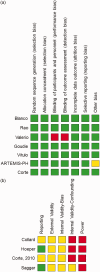Chronic use of PAH-specific therapy in World Health Organization Group III Pulmonary Hypertension: a systematic review and meta-analysis
- PMID: 28680574
- PMCID: PMC5448533
- DOI: 10.1086/690017
Chronic use of PAH-specific therapy in World Health Organization Group III Pulmonary Hypertension: a systematic review and meta-analysis
Abstract
Pulmonary hypertension (PH) complicating chronic obstructive pulmonary disease (COPD-PH) and interstitial lung disease (ILD-PH) (World Health Organization [WHO] Group III PH) increases medical costs and reduces survival. Despite limited data, many clinicians are using pulmonary arterial hypertension (PAH)-specific therapy to treat WHO Group III PH patients. To further investigate the utility of PAH-specific therapy in WHO Group III PH, we performed a systematic review and meta-analysis. Relevant studies from January 2000 through May 2016 were identified in the MEDLINE, EMBASE, and COCHRANE electronic databases and www.clinicaltrials.gov. Change in six-minute walk distance (6MWD) was estimated using random effects meta-analysis techniques. Five randomized controlled trials (RCTs) in COPD-PH (128 placebo or standard treatment and 129 PAH-medication treated patients), two RCTs in ILD-PH (23 placebo and 46 treated patients), and four single-arm clinical trials (50 patients) in ILD-PH were identified. Treatment in both COPD-PH and ILD-PH did not worsen hypoxemia. Symptomatic burden was not consistently reduced but there were trends for reduced pulmonary artery pressures and pulmonary vascular resistance with PAH-specific therapy. As compared to placebo, 6MWD was not significantly improved with PAH-specific therapy in the five COPD-PH RCTs (42.7 m; 95% confidence interval [CI], -1.0 - 86.3). In the four single-arm studies in ILD-PH patients, there was a significant improvement in 6MWD after PAH-specific treatment (46.2 m; 95% CI, 27.9-64.4), but in the two ILD-PH RCTs there was not an improvement (21.6 m; 95% CI, -17.8 - 61.0) in exercise capacity when compared to placebo. Due to the small numbers of patients evaluated and inconsistent beneficial effects, the utility of PAH-specific therapy in WHO Group III PH remains unproven. A future clinical trial that is appropriately powered is needed to definitively determine the efficacy of this widely implemented treatment approach.
Keywords: COPD; ILD; WHO Group 3 Pulmonary Hypertension; chronic lung disease; pulmonary hypertension.
Figures




References
-
- Andersen CU, Mellemkjaer S, Hilberg O, et al. Pulmonary hypertension in interstitial lung disease: Prevalence, prognosis and 6 min walk test. Respir Med 2012; 106: 875–882. - PubMed
-
- Andersen KH, Iversen M, Kjaergaard J, et al. Prevalence, predictors, and survival in pulmonary hypertension related to end-stage chronic obstructive pulmonary disease. J Heart Lung Transplant 2012; 31: 373–380. - PubMed
-
- Behr J, Ryu JH. Pulmonary hypertension in interstitial lung disease. Eur Respir J 2008; 31: 1357–1367. - PubMed
-
- Burrows B, Kettel LJ, Niden AH, et al. Patterns of cardiovascular dysfunction in chronic obstructive lung disease. N Engl J Med 1972; 286: 912–918. - PubMed
-
- Hamada K, Nagai S, Tanaka S, et al. Significance of pulmonary arterial pressure and diffusion capacity of the lung as prognosticator in patients with idiopathic pulmonary fibrosis. Chest 2007; 131: 650–656. - PubMed
Grants and funding
LinkOut - more resources
Full Text Sources
Other Literature Sources
Research Materials

